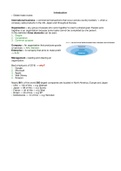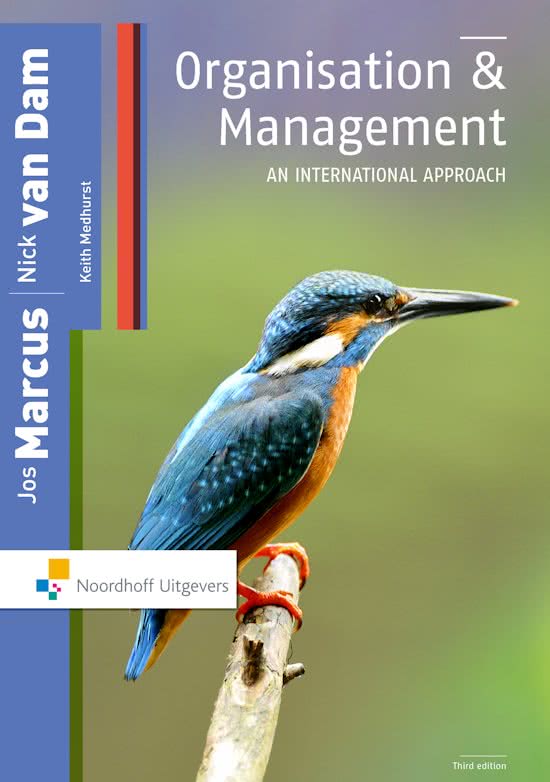Introduction
• Oldest trade routes
International business = commercial transactions that occur across country borders -> when a
company sells products in the US, Japan and throughout Europe.
Organisation = any group of people who work together to reach a shared goal. People work
together in an organisation because some tasks cannot be completed by one person.
In this de nition three elements can be seen:
1. People
2. Cooperation
3. Common purpose
Company = An organisation that produces goods
or services -> NHL Stenden
Enterprise = A company that aims to make pro t
-> KLM
Management = leading and steering an
organisation.
Best employers of 2018: -> why?
1. Google
2. Microsoft
3. Apple
4. Walt Disney
5. Amazon
Nearly 90% of the world 500 largest companies are located in North-America, Europe and Japan
• USA -> 132 of this -> e.g Walmart
• Japan -> 68 of this -> e.g Toyota
• France -> 32 of this -> e.g Total
• Britain -> 26 of this -> e.g BP
• Netherlands -> 12 of this -> e.g Heineken
fi fi
, Chapter 1: the evolution of organisation and management thoughts
An organisation is seen a whole that is made of closely connected parts
• Consistent across all parts and considers external in uences
Management: Combining and structuring tasks, people and resources in such a way that goals of
an organisation are reached -> management: leading and steering of an organisation.
• There is no one best way of management
• Di erent circumstances require di erent structures, task division and working methods.
• Changing and complex external circumstances a ect an organisation’s choice of strategy,
structures and systems to be adopted.
Organisational behaviour: an interdisciplinary science that studies the behaviour of
organisations and the factors that determine this behaviour, and identi es how organisations can
be managed most e ectively. This de nition has two aspects:
1. A descriptive aspect: incl. motives and consequences
2. A prescriptive aspect: the organisational design
Interdisciplinary = inter-between/ covers more than one eld of study
Multidisciplinary = multiple/ combining or involving more than one discipline or eld of study
Organisational behaviour:
• It helps the process of management, providing targeted persuasion and guidance within the
organisation.
• It is goal orientated, so helps management to be most e ective.
History of international business:
The development of trading:
• Trading between various tribes in various cross-border geographical regions
• E.g trade routes, the ‘’Silk route’’, the oldest trade route (1st century BC)
• Connecting Europe, Middle East, Asia
• Link Roman and Chinese civilisation
• Commodities such as silk, iron, pottery,
bronze transported to the west in exchange
for metals, wool, glass etc.
• Other: Roman trade routes (50 BC to 500
AD), African trade route (1000 AD to 1500
AD, Indian maritime routes (800 AD) and
Spanish trade routes (15th and 16th century),
Portuguese (16th century).
• The rst international trading companies
were set up and funded by national
governments with the aim of supporting their
commercial policies, for example:
– English East India Company (1600),
– Dutch East India Company (1602),
– French West India Company (1664),
– Royal African Company (1663),
– Hudson’s Bay Company (1670).
Between the establishment of the rst
international trading companies and the
beginning of 20th century, number of and
size of so-called multinationals increased.
ff fi ff fiff fi ff fl fffi fi fi
, Management principles for excellent companies
1. Strong action orientation;
2. Close customer relationships;
3. The creation of entrepreneurship and autonomy;
4. Employees are the key source of productivity;
5. Hands-on, driven by clear values;
6. Stick to what you know best;
7. Simple structure and lean supporting divisions;
8. A structure that is both centralised and decentralised.
Organisational structures of Mintzberg:
1. Entrepreneurial / Start-up (small clothing shop)
2. Machine bureaucracy (think of macdonalds)
3. Professional bureaucracy (think of a hospital)
4. Diversi ed form (think of Philips)
5. Adhocracy (innovative) (think of the creative people)
6. Missionary (idealogical) (think of the church, priestess)
7. Political organisation
Jim Collins; author of ‘Good to Great’ (2001)
Outstanding companies can be recognised by:
1. level 5 leaders
2. rst who, then what (right people in the bus, before drive the bus)
3. a culture of self-discipline
4. a CEO with almost heroic commitment
5. insider CEOs
6. respect for other players
7. Balanced and long-serving CEOs
Steve Jobs; master of simplicity
– 7 rules of success
– Changed the way people communicate
– Sidestepped the industry leader with a di erent focus
fi fi ff
, Chapter 2: Environmental in uences
Organisations: can be a ected by those environmental
in uences that it does not have signi cant control over.
For example -> macro factors (indirect in uence):
• Economic developments
• Technological developments
• Climate
• Demographic development
• Political factors
• Social factors
(Destep)
External factors have an indirect in uence on
organisations, while organisations can only in uence
external factors to a limited extent.
Environmental factors
Economic growth in the past few decades can be linked to a rise in pollution, and the exhaustion
of natural resources.
• Some of the main environmental problems include:
› The loss of biodiversity
› Climate change
› Over exploitation of natural resources
› Health threats
› Threats to external safety
› Changes to the environment we live in
Technological factors
Technological development is continuous, market driven and can deliver better products cheaper
& faster.
Two sectors where major changes are expected are:
• biotechnology – food / pharmaceutical / agriculture
• information technology – processes, integration / communication / economies of scale /
decisions
Demographic factors
Demographic factors are de ned as the size, growth and composition of the population
Today’s challenges include an increasing world population, while the Western World is
experiencing:
• Extended life expectancy
• Demographic ageing
• Shrinking work force
• Greater care needs
• Active older generations
Economic factors
An organisation’s success can be linked to the economy.
Depend also on international economic developments:
• Economic growth in other countries;
• Exchange rates and currency swings;
• Changes in base interest rates in other countries;
• Labour costs and wages in foreign countries.
fl
ff fi fiflfl fl fl






